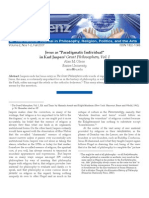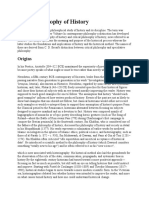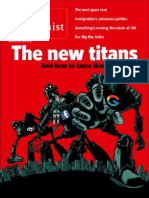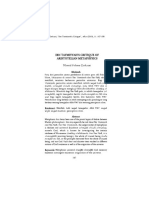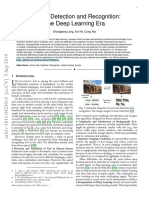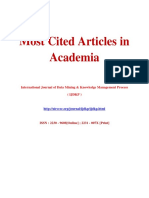Professional Documents
Culture Documents
Fake Information Detection by Gaining Knowledge of The Usage of Machine Learning
Original Title
Copyright
Available Formats
Share this document
Did you find this document useful?
Is this content inappropriate?
Report this DocumentCopyright:
Available Formats
Fake Information Detection by Gaining Knowledge of The Usage of Machine Learning
Copyright:
Available Formats
Volume 7, Issue 5, May – 2022 International Journal of Innovative Science and Research Technology
ISSN No:-2456-2165
Fake Information Detection by Gaining Knowledge of
the Usage of Machine Learning
M. Srikanth Yadav 1 , P. Maneesh 2, Y. Rajmohan 3,
1
Professor, Department of Information Technology, Vignan’s Foundation for Science,
Technology & Research , Guntur AP-522213, India
2,3
UG student, Department of Infotmation Technology Vignan’s Foundation for Science,
Technology & Research, Guntur AP-522213, India
Abstract:- Many individuals get their news from sources become a major emphasis. Fake news sources do not adhere
they don't know anymore, including Facebook, to the norms and processes of the mainstream media to assure
WhatsApp, Twitter, and Telegram, which are all popular the accuracy and credibility of their material. Those who are
social media platforms nowadays. False information preoccupied with politics and stock prices are the primary
spread through online is faltering a major origin of audience for fake news, which has the potential to negatively
concern for many persons. Some of the variables that impact their mental well-being and even contribute to
contribute to the propagation of fake news include cheap depression- like symptoms. It is better to concentrate on the
cost, easy accessibility via social media, and a wide variety approved reports released by authorized publications rather
of low-budget internet news sources. More than just the than personal pieces to minimize the spread of false news.
content of a story engaged users' earlier postings and
social actions may reveal a lot of information about their [3] According to a few claims, bogus news was
thoughts on the news and have the potential to circulating before Christ (BC) as well. However, it was the
significantly enhance the detection of false stories. online creation of print media, i.e., the printing press, in 1439 [4]
media has interested individuals over all world in that began its widespread dissemination. Eventually, in the
propagating fake information owing to its simple late 1990s, the era of social media emerges, allowing for the
availability, cost-effectiveness, and convenience of rapid and enormous diffusion of knowledge [5]. As a result,
information sharing. Creating fake news for personal or it becomes a haven for those who want to spread
commercial advantage can be done. It may also be utilized misinformation. On Facebook, less than one-tenth of one
for other personal gains such as slander renowned percent of all public information was manipulated by bad
individuals, alteration of authority laws, etc. As a result, actors [6, 7]. When speculations regarding Steve Jobs' health
a variety of research methods have been used to identify were reported as factual in 2008, the stock price of Apple Inc.
false news and prevent its disastrous repercussions. fluctuated greatly [8]. Research suggests that during the 2016
Motivated by the problems, we give a complete overview US presidential election, nearly 19 million bot accounts
of the available fake news recognition algorithms in this tweeted in favor of either Trump or Clinton, which precisely
study. After that, we use ML models like Random Forest depicts how social media considerably helps to the
(RF), Naive Bayes (NB), Random Tree (RT), Linear development and transmission of fake news.
Regression (LR), and Support Vector Machines (SVM) to
learn our data (SVM). We then applied these models, False news has a negative influence on people's social
which have shown good results in accuracy and other and personal lives. On three levels, the spread of incorrect
assessment measures, such as F1-score, recall, and information is harmful to a community's cohesiveness and
faithfulness. productivity.
Thus, residents are left with a skewed understanding
Keywords:- Fake News Detection, Social Media, Fake News
stay in the media bubble while being ignorant about the
Classification, Machine Learning, SVM, NB
world, and
I. INTRODUCTION the effectiveness and suggestiveness of much false news
[18] make it believable to feel scared or enraged on a
[1] The term "fake news" refers to modified material mental level.
that mimics news media content in nature but not in
managerial structure or aim. It's becoming increasingly False news has had a major impact on our economy and
difficult to track reputable news sources in the deluge of democracy. Rumor and false news have a lot in common, yet
information being sent via online media, newspapers, blogs, they are distinct concepts. Disinformation, sometimes known
forums, and magazines. Fake news is on the rise, which as fake news, is purposefully spread. Unconfirmed and
necessitates the use of effective analytical techniques that can doubtful information that is transmitted without the intent of
tell the truth about internet information [2]. False news has a deception is known as a rumor. Spreaders' motives might be
major influence (good or bad) on social media users who difficult to ascertain on social media platforms. Any
often use the site. A gloomy effect on the readers must be inaccurate or misleading information is thus labeled as such
avoided at all costs. As a result, the development of on the Internet. It's difficult to tell the difference between
algorithms and approaches for detecting false news has authentic and fraudulent information. This problem has been
IJISRT22MAY1076 www.ijisrt.com 988
Volume 7, Issue 5, May – 2022 International Journal of Innovative Science and Research Technology
ISSN No:-2456-2165
tackled in a variety of ways. False information may be paragraphs for each news item.
detected using several machine learning (ML) approaches,
such as knowledge verification, natural language processing [6] describe an example that aims to tackle the challenge
(NLP), and sentiment analysis [16]. Textual information of detecting fake news before it is widely disseminated. When
extracted from the article's content, such as statistical text it comes to evaluating news documents, user comments can
characteristics and emotional information, was the focus of be useful, however in the early stages of news distribution,
early study. there aren't many remarks. A Grover- based neural network
model was created to aid with categorization as a result. They
Fake news identification has been the subject of several experimented with posting comments to evaluate the efficacy
studies [5]. Existing research on deep learning architectures of our proposed strategy for early identification.
for identifying false news does not give a comprehensive
overview, according to our findings. Studies on how to III. METHODOLOGY
identify false news mostly focus on machine learning (ML)
methods, with little attention paid to debunking techniques A. Dataset
(DL) [3]. NLP strategies are listed and discussed in detail, Buzz Feed News provided the dataset that was used to
including their advantages and disadvantages. In this study, build the model and run tests on it. According to Bozsum’s
we conducted a comprehensive review of existing DL-based social media analysis services, 167 websites that regularly
research. As seen in Table 1, we have contributed to the produce material were analyzed to determine which posts
existing body of knowledge through our study. Fake news performed best on Facebook. In this dataset, Facebook posts
identification is the focus of this work, which tries to address are represented as news items. They were gathered from
the shortcomings and benefits of earlier studies. Politico, ABC News, and CNN, the three most popular
political news websites. [11].
II. RELATED WORK
A New Set of Benchmark Data for the Detection of Fake
Text representation was created utilizing tokenization News. collection of more than 12.8K hand-labeled brief
techniques such as TF, TFIDF, and embedding [1]. Individual phrases in diverse contexts over the course of a decade
models were trained on various text representation properties, obtained from this HTTP URL. It is also possible to do fact-
including LR (DT), KNN (RF), and SVM (SVM is a deep checking studies using this dataset [9].
learning model). To select the best individual model, they
utilized a corrected version of McNamar’s test to examine if B. Data pre-processing
the model with the greatest accuracy varied substantially from To represent complicated structures with attributes,
other models on both datasets. Their last technique was to train binarize attributes, alter discrete attributes, persist, and
another RF model based on the predictions of all individual manage lost and obscure attributes, data pre-processing is
models to improve the performance of all models. employed. The data that may be obtained from Twitter is
disjointed and irregular in nature.
Newly proposed source-based methods rely on user
information, according to [2]. With this notion, many of the The initial stage in the data preparation procedure is the
shortcomings of previous methods may be simply fixed. As a tokenization or segmentation of tweets. A tokenizing word is
result, they provide a strategy based on information regarding an important unit in text analysis. Following Twitter
the information's source and propagators. processing, punctuation markers such as periods, semicolons,
and commas are removed from the dataset. Exclamation
Text semantic attention and propagation structure points and quote marks are also omitted. "Stop words" are no
attention are combined in the MVAN to capture important longer in use. The most used terms in a piece of writing are
hidden cues and information in the source tweet text and known as "stop words". If a term appears more than once in
propagation structure simultaneously. [3] An evaluation a paragraph or sentence, it has almost no meaning.
based on two public datasets found that MVAN had great
performance and adequate interpretation skills. MVAN can Transforming lowercase to uppercase letters: In text
also help detect fake news early and effectively. analysis, all capital and lowercase letters are treated equally.
The number of feature words increases when they use both
Thought-provoking in deception detection, automatic capital and lowercase letters in our training corpus.
identification of fake news is a huge political and social issue
in the actual world. A dependency tree was constructed using A critical step in data preparation is trimming. The
Deep Learning (GRU) in this study to identify the elimination of unnecessary affixes reduces the complexity of
characteristics of genuine and fake news. For instance, see A. words to their most basic form.
Uppal et al [5]. Since the datasets were evenly distributed,
even though accuracy is not normally the most critical
criterion for evaluating a model, high accuracy, in this case, C. Feature Extraction
implies that the model functioned well. The Kaggle dataset for Many variables need a great quantity of computer power
CNN was the best for TFIDF. Using the TFIDF, the Kaggle and memory. Classification algorithms may overfit the
dataset yielded good results for all three models. TFIDF is an training samples, resulting in unsatisfactory results when
excellent approach if the dataset contains extensive applied to fresh data. To address these issues, feature
IJISRT22MAY1076 www.ijisrt.com 989
Volume 7, Issue 5, May – 2022 International Journal of Innovative Science and Research Technology
ISSN No:-2456-2165
extraction is a method of constructing combinations of connecting nodes progressively in RNN. The previous step's
variables to describe the data with acceptable precision. Text output acts as the input for the following step. Time- and
mining commonly makes use of feature extraction and feature sequence-based predictions benefit greatly from RNNs.
selection. When compared to CNN, RNN is less feature compatible.
Recurrent neural networks (RNNs) are well-suited to the
Choosing the right method for reducing features is examination of successive texts and phrases. Tanh and ReLU
critical since feature reduction has a huge impact on text can be used as activation functions, however, they cannot
categorization outcomes. Information Gain, Mutual handle very lengthy sequences.
Information, and Principal Component Analysis are among
the most often used techniques for reducing the number of In NLP, LSTM models take the lead. An artificial
features in a dataset. recurrent neural network architecture called LSTM is
employed in deep learning. RNN has been further developed
IV. CLASSIFICATION MODELS into LSTM. Due to the time required for back-propagation,
RNNs are incapable of learning long-term dependencies,
Due to their promising results in a wide range of sectors, especially when it comes to the evolving backflow of errors.
such as communication and networking, computer vision and Long Short-Term Memory (LSTM) does not have the ability
intelligent transportation as well as voice recognition and to store long-term memories. LSTM has three gates: an input
NLP, deep learning models have recently witnessed an gate, an output gate, a forget gate, and a cell. The concealed
amazing rise in popularity. Traditional machine learning state is calculated using a mixture of the three. Over a long
approaches can't compete with the advantages of deep period of time, the cell may store data. Because of this, the
learning. Deep learning is a kind of machine learning that word's relationship at the beginning of the content might
excels at spotting bogus news with pinpoint accuracy. Most influence the word's output later in the phrase. The vanishing
machine learning approaches are based on characteristics that gradient problem may be effectively addressed with LSTM.
are hand-crafted by the author. Because feature extraction
assignments are difficult and time-consuming, biased features V. RESULTS AND DISCUSSION
may emerge. Fake news identification has been a failure for
ML techniques. because the curse of dimensionality is a For prior DL research, CNN-LSTM ensembles have
consequence of ML techniques producing high-dimensional been employed. As a result, the accuracy of the model was
representations of language information. Because of their somewhat lower than the current best CNN model. Precision
superior capacity to extract features, current neural network and recall, on the other hand, were significantly enhanced. By
models have surpassed conventional models in terms of applying Bi-LSTM, Asghar et al. saw an improvement in the
performance. On the other hand, DL systems can learn model's efficiency. Bi-LSTM preserves information from
portrayal buried inside uncomplicated data. Hidden previous and future contexts before feeding it into the CNN
characteristics can be found in both news content and context. model for processing. The LSTM-CNN developed by Ajao et
al. was trained on a smaller dataset than is common for CNNs
For ambiguous detection challenges, a few deep and RNNs. When it comes to the categorization of false news,
learning models have been developed the most intriguing the studies described above only analyzed text-based criteria;
models are those based on convolutional and random neural however, incorporating additional elements might yield a
networks. Researchers are working to improve CNN's false more significant outcome. Research by Amine et al. [131]
news detector's effectiveness by using the network's feature used two convolutional neural networks to integrate metadata
extraction and classification capabilities. CNN’s, on the with text, whereas most studies utilized CNN in conjunction
other hand, are becoming increasingly popular in NLP as with LSTM. Fake news detection may be much improved by
well. n-gram patterns may be mapped with this tool. merging information with the text, as demonstrated by these
Because CNN is an unsupervised feed-forward multilayer researchers. In addition, our technique outperforms the text-
neural network, it is related to the multilayer perceptron only deep learning model on real-world datasets. Kumar et al.
(MLP). Each hidden layer of the CNN is comprised of a
series of input layers, followed by an output layer and a final [86] went one step farther by using an attention layer.
layer. When it comes to image identification, CNNs play an Helps CNN-C learn to focus on specific areas of input
important role. sequences rather than the entire series of inputs. Using
CNNCLSTM's attention mechanism was shown to be
In the world of artificial intelligence, one sort of neural effective but by a narrow margin. DL-based investigations'
network is the RNN. A directed graph is formed by results are summarized in Table 1.
IJISRT22MAY1076 www.ijisrt.com 990
Volume 7, Issue 5, May – 2022 International Journal of Innovative Science and Research Technology
ISSN No:-2456-2165
Table 1. The table contains the result in accuracy of DL-based studies along with used methods and NLP techniques.
Method NLP techniques Accuracy
CNN 1T-IDF 0.9830
Deep CNN GloVE 0.9836
CNN TensorFlow embedding layer 0.9600
CNN-ELS-1M GloVE 0.9471
Bi-directional LSTM-RNN CHOW 0.9875
Passive-aggressive 1F-1DF 0.8380
fake BERT GloVE, BERT 0.9890
VI. CONCLUSION [9]. M. K. Elhadad, K. F. Li, and F. Gebali, ``Fake news
detection on social media: A systematic survey,'' in
As the use of social media grows, so does the Proc. IEEE Paci_c Rim Conf. Commun., Comput.
proliferation of fake news. Researchers are also working hard Signal Process. (PACRIM), Aug. 2019, pp. 1_8.
to identify ways to prevent the spread of fake news in our [10]. A. Bondielli and F. Marcelloni, ``A survey on fake news
culture. This survey discusses the most important works on and rumour detection techniques,'' Inf. Sci., vol. 497, pp.
false news categorization. Understanding the most recent 38_55, Sep. 2019. [Online].
techniques to false news identification is critical since the [11]. Available: http://www.sciencedirect.
most advanced frameworks are the leaders in this field. As a com/science/article/pii/S0020025519304372
result, we examined NLP and advanced DL techniques for [12]. P. Meel and D. K. Vishwakarma, ``Fake news, rumor,
identifying bogus news. In our paper, we presented a information pollution in social media and web: A
taxonomy of methods for spotting bogus news. contemporary survey of state-of-the- arts, challenges
and opportunities,'' Expert Syst. Appl., vol. 153, Sep.
REFERENCES 2020, Art. no. 112986.
[13]. K. Sharma, F. Qian, H. Jiang, N. Ruchansky, M. Zhang,
[1]. H. Allcott and M. Gentzkow, ``Social media and fake and Y. Liu, ``Combating fake news: A survey on
news in the 2016 election,'' J. Econ. Perspect., vol. 31, identi_cation and mitigation techniques,'' ACM Trans.
no. 2, pp. 36_211, 2017. Intell. Syst. Technol., vol. 10, no. 3, pp. 1_42, May
[2]. T. Rasool, W. H. Butt, A. Shaukat, and M. U. Akram, 2019.
``Multi-label fake news detection using multi-layered [14]. X. Zhou and R. Zafarani, ``A survey of fake news:
supervised learning,'' in Proc. 11th Int. Conf. Comput. Fundamental theories, detection methods, and
Autom. Eng., 2019, pp. 73_77. opportunities,'' ACMComput. Surv., vol. 53, no. 5, pp.
[3]. X. Zhang and A. A. Ghorbani, ``An overview of online 1_40, 2020.
fake news: Characterization, detection, and discussion,'' [15]. B. Collins, D. T. Hoang, N. T. Nguyen, and D. Hwang,
Inf. Process. Manage., vol. 57, no. 2, Mar. 2020, Art. no. ``Trends in combating fake news on social media_A
102025. [Online]. Available: survey,'' J. Inf. Telecommun., vol. 5, no. 2, pp. 247_266,
http://www.sciencedirect.com/science/article/pii/S0306 2021.
457318306794 [16]. A. Zubiaga, A. Aker, K. Bontcheva, M. Liakata, and R.
[4]. Abdullah-All-Tanvir, E. M. Mahir, S. Akhter, and M. R. Procter, ``Detection and resolution of rumours in social
Huq, ``Detecting fake news using machine learning and media: A survey,'' ACM Comput. Surveys, vol. 51, no.
deep learning algorithms,'' in Proc. 7th Int. Conf. Smart 2, pp. 1_36, Jun. 2018.
Comput. Commun. (ICSCC), Jun. 2019, pp. 1_5. [17]. M. D. Ibrishimova and K. F. Li, ``A machine learning
[5]. K. Shu, A. Sliva, S. Wang, J. Tang, and H. Liu, ``Fake approach to fake news detection using knowledge
news detection on social media: A data mining veri_cation and natural language processing,'' in Proc.
perspective,'' ACM SIGKDD Explorations Newslett., Int. Conf. Intell. Netw. Collaborative Syst. Ch m,
vol. 19, no. 1, pp. 22_36, 2017. Switzerland: Springer, 2019, pp. 223_234.
[6]. R. Oshikawa, J. Qian, and W. Y. Wang, ``A survey on [18]. H. Ahmed, I. Traore, and S. Saad, ``Detecting opinion
natural language processing for fake news detection,'' spams and fake news using text classi_cation,'' Secur.
2018, arXiv:1811.00770. Privacy, vol. 1, no. 1, p. e9, Jan. 2018.
[7]. S. B. Parikh and P. K. Atrey, ``Media-rich fake news [19]. H. Ahmed, I. Traore, and S. Saad, ``Detection of online
detection: A survey,'' in Proc. IEEE Conf. Multimedia fake news using N-gram analysis and machine learning
Inf. Process. Retr. (MIPR), Apr. 2018, pp. 436_441. techniques,'' in Proc. Int. Conf. Intell., Secure,
[8]. A. Habib, M. Z. Asghar, A. Khan, A. Habib, and A. Dependable Syst. Distrib. Cloud Environ. Switzerland:
Khan, ``False information detection in online content Springer, 2017, pp. 127_138.
and its role in decision making: A systematic literature [20]. B. Bhutani, N. Rastogi, P. Sehgal, and A. Purwar, ``Fake
review,'' Social Netw. Anal. Mining, vol. 9, no. 1, pp. news detection using sentiment analysis,'' in Proc. 12th
1_20, Dec. 2019. Int. Conf. Contemp. Comput. (IC), Aug. 2019, pp. 1_5.
IJISRT22MAY1076 www.ijisrt.com 991
Volume 7, Issue 5, May – 2022 International Journal of Innovative Science and Research Technology
ISSN No:-2456-2165
[21]. C. Castillo, M. Mendoza, and B. Poblete, ``Information
credibility on Twitter,'' in Proc. 20th Int. Conf. World
Wide Web, Mar. 2011, pp. 675_684, doi:
10.1145/1963405.1963500.
[22]. O. Ajao, D. Bhowmik, and S. Zargari, ``Sentiment
aware fake news detection on online social networks,''
in Proc. IEEE Int. Conf. Acoust., Speech Signal Process.
(ICASSP), May 2019, pp. 2507_2511.
[23]. B. Ghanem, P. Rosso, and F. Rangel, ``An emotional
analysis of false information in social media and news
articles,'' ACM Trans. Internet Technol., vol. 20, no. 2,
pp. 1_18, May 2020.
[24]. A. Giachanou, P. Rosso, and F. Crestani, ``Leveraging
emotional signals for credibility detection,'' in Proc.
42nd Int. ACM SIGIR Conf. Res. Develop. Inf. Retr.,
Jul. 2019, pp. 877_880.
[25]. D. Khattar, J. S. Goud, M. Gupta, and V. Varma,
``MVAE: Multimodal variational autoencoder for fake
news detection,'' in Proc. World Wide Web Conf., May
2019, pp. 2915_2921.
[26]. N. J. Conroy, V. L. Rubin, and Y. Chen, ``Automatic
deception detection: Methods for _nding fake news,'' in
Proc. 78th ASIST Annu. Meeting, Inf. Sci. Impact, Res.
Community, vol. 52, no. 1, pp. 1_4, 2015.
[27]. G. Eason, B. Noble, and I. N. Sneddon, “On certain
integrals of Lipschitz-Hankel type involving products of
Bessel functions,” Phil. Trans. Roy. Soc. London, vol.
A247, pp. 529–551, April 1955.
IJISRT22MAY1076 www.ijisrt.com 992
You might also like
- Impact of Fake News on Philippine Politics and EconomyDocument22 pagesImpact of Fake News on Philippine Politics and EconomyJohn LloydNo ratings yet
- Uncovering Fake News by Means of Social Network AnalysisDocument18 pagesUncovering Fake News by Means of Social Network AnalysisijansjournalNo ratings yet
- 3) 21 Lessons For The 21st Century by Yuval Noah Harari - SummaryDocument9 pages3) 21 Lessons For The 21st Century by Yuval Noah Harari - Summarysvshankar72No ratings yet
- Ideas That Changed The WorldDocument19 pagesIdeas That Changed The Worldmmmmm100% (1)
- Description of Situations An Essay in Contextualist EpistemologyDocument110 pagesDescription of Situations An Essay in Contextualist Epistemologyalexei saenzNo ratings yet
- Doing Philosophy: Mr. Ernesto Bais A. Arcenas JRDocument44 pagesDoing Philosophy: Mr. Ernesto Bais A. Arcenas JRJoshua OcheaNo ratings yet
- 100 Ideas That Changed The WorldDocument3 pages100 Ideas That Changed The WorldЯнаNo ratings yet
- European Journal of SociologyDocument49 pagesEuropean Journal of SociologyFiqh VredianNo ratings yet
- The Science of Fake News: 1. The List of Author Affiliations Is Provided in The Supplementary MaterialsDocument8 pagesThe Science of Fake News: 1. The List of Author Affiliations Is Provided in The Supplementary MaterialsAntônio MotaNo ratings yet
- An Academic Analysis of The Notion of Biopower, Biopolitics and Governmentality According To Michel FoucaultDocument13 pagesAn Academic Analysis of The Notion of Biopower, Biopolitics and Governmentality According To Michel FoucaultMayanestudentNo ratings yet
- Greek Philosophy and Heraclitus PDFDocument10 pagesGreek Philosophy and Heraclitus PDFtraxster100% (1)
- Jesus As Paradigmatic Individual in Jaspers' GREAT PHILOSOPHERSDocument5 pagesJesus As Paradigmatic Individual in Jaspers' GREAT PHILOSOPHERSPahndeepah100% (1)
- The Rise of Misinformation in Online and Broadcast NewsDocument4 pagesThe Rise of Misinformation in Online and Broadcast NewsBilly Cancea-O'DuinninNo ratings yet
- FreelanceDocument24 pagesFreelanceUmme NamiraNo ratings yet
- How Will Climate Change Affect The Cairns Region?Document2 pagesHow Will Climate Change Affect The Cairns Region?kurabyqld100% (1)
- Pholosophy of HistoryDocument11 pagesPholosophy of HistoryKara KaneNo ratings yet
- Human Studies Volume 4 Issue 1 1979 (Doi 10.1007/bf02127456) Steven McGuire - Interpretive Sociology and Paul RicoeurDocument22 pagesHuman Studies Volume 4 Issue 1 1979 (Doi 10.1007/bf02127456) Steven McGuire - Interpretive Sociology and Paul RicoeurpaswordNo ratings yet
- Business Partner B2Plus Ex Class Practice WorkSheet - U4Document5 pagesBusiness Partner B2Plus Ex Class Practice WorkSheet - U4Mộc LanNo ratings yet
- Assignment 2-Online BusinessDocument6 pagesAssignment 2-Online Businessmiss jeonNo ratings yet
- 10 1136@bmj m1326 PDFDocument2 pages10 1136@bmj m1326 PDFemmanuel prahNo ratings yet
- Swim Your Ground Towards A Black and Blue HumanitiesDocument24 pagesSwim Your Ground Towards A Black and Blue HumanitiesJustin DunnavantNo ratings yet
- Economics Project Final HimangDocument29 pagesEconomics Project Final HimangHimangSaraswatNo ratings yet
- Andrea Rehberg Nietzsche and The Politics of DifferenceDocument353 pagesAndrea Rehberg Nietzsche and The Politics of DifferencepatriamilitanteNo ratings yet
- CNF Reviewer 2ndquarter Part2Document4 pagesCNF Reviewer 2ndquarter Part2Althea JaneNo ratings yet
- A_Beginner_s_Guide_to_Prompt_Engineering_with_ChatGPT_SlidesDocument58 pagesA_Beginner_s_Guide_to_Prompt_Engineering_with_ChatGPT_Slidesyacine.hedefNo ratings yet
- Duane Rousselle - After Post-Anarchism-Repartee, LBC Books (2012)Document296 pagesDuane Rousselle - After Post-Anarchism-Repartee, LBC Books (2012)sergiolefNo ratings yet
- Short Answer Study Guide Questions - The Adventures of Tom SawyerDocument3 pagesShort Answer Study Guide Questions - The Adventures of Tom SawyersddwdefNo ratings yet
- Debate On The Democracy of The Future, in The Digital Era (From Theory To Practice)Document49 pagesDebate On The Democracy of The Future, in The Digital Era (From Theory To Practice)AJHSSR JournalNo ratings yet
- Social Psychological and Personality Science 2012 Barnes 100 7Document9 pagesSocial Psychological and Personality Science 2012 Barnes 100 7Hilene PachecoNo ratings yet
- Social Action - Max WeberDocument3 pagesSocial Action - Max WeberDavid TanNo ratings yet
- IPA Assignment Analyzes New Public AdministrationDocument8 pagesIPA Assignment Analyzes New Public AdministrationKumaran ViswanathanNo ratings yet
- TOK Key Thinkers On The Human SciencesDocument11 pagesTOK Key Thinkers On The Human SciencesBob KinawaNo ratings yet
- A Juggling Act: A Feminist Post-Structuralist Analysis of Girls' and Boys' Talk in The Secondary ClassroomDocument15 pagesA Juggling Act: A Feminist Post-Structuralist Analysis of Girls' and Boys' Talk in The Secondary ClassroomAlicia PintusNo ratings yet
- FINANCE AND GLOBALISATION: TOWARDS A POLITICAL ECONOMY APPROACHDocument27 pagesFINANCE AND GLOBALISATION: TOWARDS A POLITICAL ECONOMY APPROACHMarcoKreNo ratings yet
- Business Management NotesDocument27 pagesBusiness Management Notesjosef tomNo ratings yet
- National Science Foundation - Science and Engineering Indicators (2012)Document592 pagesNational Science Foundation - Science and Engineering Indicators (2012)EXAME.comNo ratings yet
- Essay 3Document10 pagesEssay 3api-644324562No ratings yet
- Wetlands Sanctuary: Experience Nature in the CityDocument63 pagesWetlands Sanctuary: Experience Nature in the CityAden FooNo ratings yet
- ABDC Journal Ratings ListDocument49 pagesABDC Journal Ratings ListDiễm NguyênNo ratings yet
- March 2022 TissnetprepDocument42 pagesMarch 2022 TissnetprepVishal Maurya100% (1)
- The Economist 2018-1-20Document292 pagesThe Economist 2018-1-20Jie PanNo ratings yet
- Citizen JournalismDocument1 pageCitizen JournalismJen Laurine CosicolNo ratings yet
- Paola Ricaurte Data Epistemologies Coloniality of Power 2019Document16 pagesPaola Ricaurte Data Epistemologies Coloniality of Power 2019homemverde0No ratings yet
- 1 The Critical Discourse of Liberal HumanismDocument20 pages1 The Critical Discourse of Liberal Humanismnicfrasineanu1No ratings yet
- Globalization and DigitalizationDocument11 pagesGlobalization and DigitalizationSun A Lee100% (1)
- Coaching Classroom InstructionDocument2 pagesCoaching Classroom InstructionJona PlimacoNo ratings yet
- A History of The United StatesDocument191 pagesA History of The United StatesraisssssszzNo ratings yet
- Memes, Truthiness and Public KnowledgeDocument28 pagesMemes, Truthiness and Public KnowledgeCésar Mendoza VásquezNo ratings yet
- Ibn Taymiyyah'S Critique of Aristotelian Metaphysics Hamid Fahmy ZarkasyiDocument24 pagesIbn Taymiyyah'S Critique of Aristotelian Metaphysics Hamid Fahmy ZarkasyimeltNo ratings yet
- Introduction to AI & ML: A Concise HistoryDocument31 pagesIntroduction to AI & ML: A Concise HistoryGAME ZONENo ratings yet
- Amendment to IHR Annex 7 extends yellow fever vaccine validity to lifeDocument4 pagesAmendment to IHR Annex 7 extends yellow fever vaccine validity to lifed_furlan1555No ratings yet
- The Role of Mass Media in Shaping SocietyDocument10 pagesThe Role of Mass Media in Shaping SocietyMaryana KurchakNo ratings yet
- Pearson Education Limited V Morgan AdzeiDocument21 pagesPearson Education Limited V Morgan Adzeimichael AnkomahNo ratings yet
- What is politics and how do political systems qualifyDocument26 pagesWhat is politics and how do political systems qualifyVéro NelissenNo ratings yet
- Journal Homepage: - : IntroductionDocument6 pagesJournal Homepage: - : IntroductionIJAR JOURNALNo ratings yet
- Assignment 1deepDocument9 pagesAssignment 1deepTanim SyedNo ratings yet
- Grammar Intermediate 4Document5 pagesGrammar Intermediate 4Yunda EffriantyNo ratings yet
- Assignment 12Document4 pagesAssignment 12Joey BuddyBossNo ratings yet
- Opening Report Final - 9 - 4 - 2020Document25 pagesOpening Report Final - 9 - 4 - 2020BENKEMCHI OussamaNo ratings yet
- Fake News Detection Using Machine Learning Algorithms IJERTCONV9IS03104Document10 pagesFake News Detection Using Machine Learning Algorithms IJERTCONV9IS03104favour chimaNo ratings yet
- Automatic Power Factor ControllerDocument4 pagesAutomatic Power Factor ControllerInternational Journal of Innovative Science and Research TechnologyNo ratings yet
- Intelligent Engines: Revolutionizing Manufacturing and Supply Chains with AIDocument14 pagesIntelligent Engines: Revolutionizing Manufacturing and Supply Chains with AIInternational Journal of Innovative Science and Research TechnologyNo ratings yet
- Navigating Digitalization: AHP Insights for SMEs' Strategic TransformationDocument11 pagesNavigating Digitalization: AHP Insights for SMEs' Strategic TransformationInternational Journal of Innovative Science and Research TechnologyNo ratings yet
- A Review: Pink Eye Outbreak in IndiaDocument3 pagesA Review: Pink Eye Outbreak in IndiaInternational Journal of Innovative Science and Research TechnologyNo ratings yet
- Teachers' Perceptions about Distributed Leadership Practices in South Asia: A Case Study on Academic Activities in Government Colleges of BangladeshDocument7 pagesTeachers' Perceptions about Distributed Leadership Practices in South Asia: A Case Study on Academic Activities in Government Colleges of BangladeshInternational Journal of Innovative Science and Research TechnologyNo ratings yet
- Securing Document Exchange with Blockchain Technology: A New Paradigm for Information SharingDocument4 pagesSecuring Document Exchange with Blockchain Technology: A New Paradigm for Information SharingInternational Journal of Innovative Science and Research TechnologyNo ratings yet
- Mobile Distractions among Adolescents: Impact on Learning in the Aftermath of COVID-19 in IndiaDocument2 pagesMobile Distractions among Adolescents: Impact on Learning in the Aftermath of COVID-19 in IndiaInternational Journal of Innovative Science and Research TechnologyNo ratings yet
- Studying the Situation and Proposing Some Basic Solutions to Improve Psychological Harmony Between Managerial Staff and Students of Medical Universities in Hanoi AreaDocument5 pagesStudying the Situation and Proposing Some Basic Solutions to Improve Psychological Harmony Between Managerial Staff and Students of Medical Universities in Hanoi AreaInternational Journal of Innovative Science and Research TechnologyNo ratings yet
- Review of Biomechanics in Footwear Design and Development: An Exploration of Key Concepts and InnovationsDocument5 pagesReview of Biomechanics in Footwear Design and Development: An Exploration of Key Concepts and InnovationsInternational Journal of Innovative Science and Research TechnologyNo ratings yet
- Perceived Impact of Active Pedagogy in Medical Students' Learning at the Faculty of Medicine and Pharmacy of CasablancaDocument5 pagesPerceived Impact of Active Pedagogy in Medical Students' Learning at the Faculty of Medicine and Pharmacy of CasablancaInternational Journal of Innovative Science and Research TechnologyNo ratings yet
- Formation of New Technology in Automated Highway System in Peripheral HighwayDocument6 pagesFormation of New Technology in Automated Highway System in Peripheral HighwayInternational Journal of Innovative Science and Research TechnologyNo ratings yet
- Natural Peel-Off Mask Formulation and EvaluationDocument6 pagesNatural Peel-Off Mask Formulation and EvaluationInternational Journal of Innovative Science and Research TechnologyNo ratings yet
- Drug Dosage Control System Using Reinforcement LearningDocument8 pagesDrug Dosage Control System Using Reinforcement LearningInternational Journal of Innovative Science and Research TechnologyNo ratings yet
- The Effect of Time Variables as Predictors of Senior Secondary School Students' Mathematical Performance Department of Mathematics Education Freetown PolytechnicDocument7 pagesThe Effect of Time Variables as Predictors of Senior Secondary School Students' Mathematical Performance Department of Mathematics Education Freetown PolytechnicInternational Journal of Innovative Science and Research TechnologyNo ratings yet
- Enhancing the Strength of Concrete by Using Human Hairs as a FiberDocument3 pagesEnhancing the Strength of Concrete by Using Human Hairs as a FiberInternational Journal of Innovative Science and Research TechnologyNo ratings yet
- Supply Chain 5.0: A Comprehensive Literature Review on Implications, Applications and ChallengesDocument11 pagesSupply Chain 5.0: A Comprehensive Literature Review on Implications, Applications and ChallengesInternational Journal of Innovative Science and Research TechnologyNo ratings yet
- Advancing Opthalmic Diagnostics: U-Net for Retinal Blood Vessel SegmentationDocument8 pagesAdvancing Opthalmic Diagnostics: U-Net for Retinal Blood Vessel SegmentationInternational Journal of Innovative Science and Research TechnologyNo ratings yet
- The Making of Self-Disposing Contactless Motion-Activated Trash Bin Using Ultrasonic SensorsDocument7 pagesThe Making of Self-Disposing Contactless Motion-Activated Trash Bin Using Ultrasonic SensorsInternational Journal of Innovative Science and Research TechnologyNo ratings yet
- Placement Application for Department of Commerce with Computer Applications (Navigator)Document7 pagesPlacement Application for Department of Commerce with Computer Applications (Navigator)International Journal of Innovative Science and Research TechnologyNo ratings yet
- REDLINE– An Application on Blood ManagementDocument5 pagesREDLINE– An Application on Blood ManagementInternational Journal of Innovative Science and Research TechnologyNo ratings yet
- Beyond Shelters: A Gendered Approach to Disaster Preparedness and Resilience in Urban CentersDocument6 pagesBeyond Shelters: A Gendered Approach to Disaster Preparedness and Resilience in Urban CentersInternational Journal of Innovative Science and Research TechnologyNo ratings yet
- Exploring the Clinical Characteristics, Chromosomal Analysis, and Emotional and Social Considerations in Parents of Children with Down SyndromeDocument8 pagesExploring the Clinical Characteristics, Chromosomal Analysis, and Emotional and Social Considerations in Parents of Children with Down SyndromeInternational Journal of Innovative Science and Research TechnologyNo ratings yet
- Handling Disruptive Behaviors of Students in San Jose National High SchoolDocument5 pagesHandling Disruptive Behaviors of Students in San Jose National High SchoolInternational Journal of Innovative Science and Research TechnologyNo ratings yet
- Safety, Analgesic, and Anti-Inflammatory Effects of Aqueous and Methanolic Leaf Extracts of Hypericum revolutum subsp. kenienseDocument11 pagesSafety, Analgesic, and Anti-Inflammatory Effects of Aqueous and Methanolic Leaf Extracts of Hypericum revolutum subsp. kenienseInternational Journal of Innovative Science and Research TechnologyNo ratings yet
- A Curious Case of QuadriplegiaDocument4 pagesA Curious Case of QuadriplegiaInternational Journal of Innovative Science and Research TechnologyNo ratings yet
- A Knowledg Graph Model for e-GovernmentDocument5 pagesA Knowledg Graph Model for e-GovernmentInternational Journal of Innovative Science and Research TechnologyNo ratings yet
- Analysis of Financial Ratios that Relate to Market Value of Listed Companies that have Announced the Results of their Sustainable Stock Assessment, SET ESG Ratings 2023Document10 pagesAnalysis of Financial Ratios that Relate to Market Value of Listed Companies that have Announced the Results of their Sustainable Stock Assessment, SET ESG Ratings 2023International Journal of Innovative Science and Research TechnologyNo ratings yet
- Pdf to Voice by Using Deep LearningDocument5 pagesPdf to Voice by Using Deep LearningInternational Journal of Innovative Science and Research TechnologyNo ratings yet
- Adoption of International Public Sector Accounting Standards and Quality of Financial Reporting in National Government Agricultural Sector Entities, KenyaDocument12 pagesAdoption of International Public Sector Accounting Standards and Quality of Financial Reporting in National Government Agricultural Sector Entities, KenyaInternational Journal of Innovative Science and Research TechnologyNo ratings yet
- Fruit of the Pomegranate (Punica granatum) Plant: Nutrients, Phytochemical Composition and Antioxidant Activity of Fresh and Dried FruitsDocument6 pagesFruit of the Pomegranate (Punica granatum) Plant: Nutrients, Phytochemical Composition and Antioxidant Activity of Fresh and Dried FruitsInternational Journal of Innovative Science and Research TechnologyNo ratings yet
- CVDocument2 pagesCVmahboobeh norouziNo ratings yet
- Document Automation Tool - AIBridge MLDocument11 pagesDocument Automation Tool - AIBridge MLAIBridge MLNo ratings yet
- Content#Document67 pagesContent#abhijeetmis007No ratings yet
- Major Project Synopsis FormatDocument20 pagesMajor Project Synopsis FormatRajNo ratings yet
- Virtual Fitness Trainer Using Artificial IntelligenceDocument11 pagesVirtual Fitness Trainer Using Artificial IntelligenceIJRASETPublicationsNo ratings yet
- Ege Ai Statement 2018Document24 pagesEge Ai Statement 2018Pablo Ramírez RivasNo ratings yet
- MS+in+Machine+Learning+ +AIDocument24 pagesMS+in+Machine+Learning+ +AIrajachinnuNo ratings yet
- Lords Report Highlights UK's AI Strengths and RisksDocument183 pagesLords Report Highlights UK's AI Strengths and RisksAstroNirav Savaliya100% (1)
- Real-Time Illegal Parking Detection System Based OnDocument5 pagesReal-Time Illegal Parking Detection System Based OnHanes PrasetyoNo ratings yet
- Rebooting The AIDocument1 pageRebooting The AIkaifiahmedNo ratings yet
- AI Revolutionizing Energy IndustryDocument6 pagesAI Revolutionizing Energy Industrydhrumil savalia0% (1)
- Global Transitions Proceedings: D. Aditya, R.G. Manvitha, C.L. Revanth MouliDocument8 pagesGlobal Transitions Proceedings: D. Aditya, R.G. Manvitha, C.L. Revanth MouliVarshini GorthiNo ratings yet
- Simulation platform for memristor-based neuromorphic systemsDocument16 pagesSimulation platform for memristor-based neuromorphic systemsSubhashree SarkarNo ratings yet
- Multi-Wavelet Coefficients Fusion in Deep Residual Networks For Fault DiagnosisDocument10 pagesMulti-Wavelet Coefficients Fusion in Deep Residual Networks For Fault DiagnosisjudarangocaNo ratings yet
- 1 s2.0 S2213158217302073 MainDocument8 pages1 s2.0 S2213158217302073 MainBharat TradersNo ratings yet
- Ahirwar, Kailash - Generative Adversarial Networks Projects - Build Next-Generation Generative Models Using TensorFlow and Keras. (2019, Packt Publishing LTD)Document497 pagesAhirwar, Kailash - Generative Adversarial Networks Projects - Build Next-Generation Generative Models Using TensorFlow and Keras. (2019, Packt Publishing LTD)Sayantan RoyNo ratings yet
- Analysis and Detection of Autism Spectrum Disorder Using Machine Learning Techniques-Ppt-1Document28 pagesAnalysis and Detection of Autism Spectrum Disorder Using Machine Learning Techniques-Ppt-1Deepika19 5I4100% (1)
- Learned Cardinalities: Estimating Correlated Joins With Deep LearningDocument7 pagesLearned Cardinalities: Estimating Correlated Joins With Deep LearningShalahudin Al AyyubyNo ratings yet
- GANs Overview: Theoretical Model, Evaluation Metrics, Recent DevelopmentsDocument17 pagesGANs Overview: Theoretical Model, Evaluation Metrics, Recent DevelopmentsMikeNo ratings yet
- Scene Text Detection and Recognition USING DL PDFDocument20 pagesScene Text Detection and Recognition USING DL PDFBindu MadhuriNo ratings yet
- Data Science and Machine Learning Project IdeasDocument20 pagesData Science and Machine Learning Project IdeasJune June100% (1)
- Per ElenaDocument4 pagesPer ElenaTatiana SolanoNo ratings yet
- ICDIS-2019 Paper 181Document9 pagesICDIS-2019 Paper 181Sathay AdventureNo ratings yet
- 4th Unit Aktu Machine LearningDocument9 pages4th Unit Aktu Machine LearningANMOL SINGHNo ratings yet
- Most Cited Article in Academia - International Journal of Data Mining & Knowledge Management Process (IJDKP)Document39 pagesMost Cited Article in Academia - International Journal of Data Mining & Knowledge Management Process (IJDKP)Lewis TorresNo ratings yet
- Object Detection and Segmentation On Tensor Flow UsingDocument10 pagesObject Detection and Segmentation On Tensor Flow UsingspiroNo ratings yet
- Psda Research Report: Artificial IntelligenceDocument18 pagesPsda Research Report: Artificial IntelligencePriya KhandelwalNo ratings yet
- AI Presentation Covers Key ConceptsDocument38 pagesAI Presentation Covers Key ConceptsSrijan YoutubeNo ratings yet
- AI To The Rescue and Smart Robots To Help UsDocument20 pagesAI To The Rescue and Smart Robots To Help UsHarshit GuptaNo ratings yet











